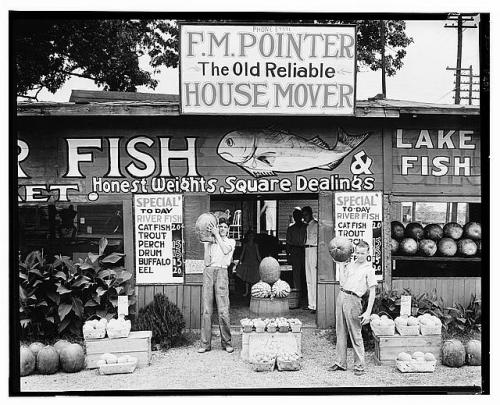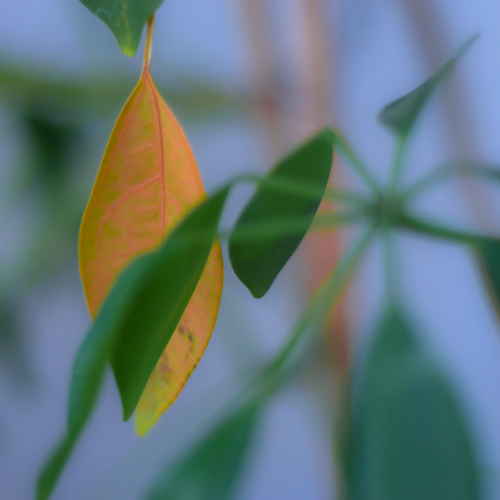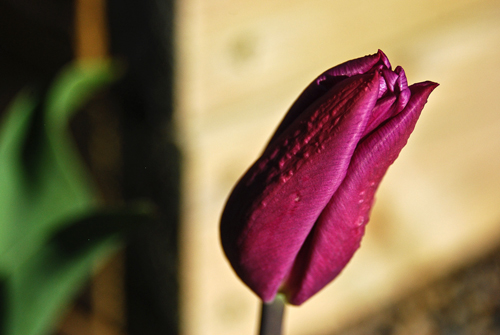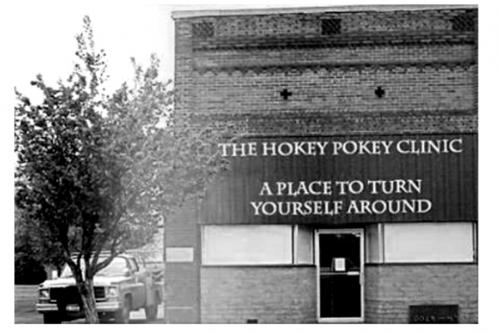Saturday Photography #2

Roadside stand near Birmingham, Alabama by Walker Evans [public domain]
Created 31 December 1935
Welcome to the second Saturday photography post. This is a weekly series for anyone who is into photography at any level from beginner to advanced. Use the comments to discuss anything in the post or anything at all about photography - however tangential. Also feel free to answer ask any questions or to post your own pics in the comments.
Scheduling note: From next week Saturday Photography will become Friday Photography and will be posted at around 5PM ET
A Bit of Photography History
Here are some documentaries about some of the photography greats. These are all people who have really impacted the art of photography. They presents a very selective look at the history of photography - it is not definitive but rather a jumping off point for further investigation.
Ansel Adams. Probably the most famous landscape photographer in the world..
[video:https://www.youtube.com/watch?v=rdCq-1MJmHw]Dorothea Lange. Lange was a documentary photographer famous for her depression era work. She was one of the photographers who worked on the Farm Security Administration’s photography program. Two others were Walker Evans and Gordon Parks.
[video:https://www.youtube.com/watch?v=yrODn0f1z0g]
Paul Strand. Ansel Adams is probably the best known American photography but Paul Strand is the most important in my opinion. He led photography out of pictorialism and into modernity. Of course many others were involved but Strand’s vision was the clearest.
[Video:https://www.youtube.com/watch?v=wv03l46FSvU]Strand was also a film maker and Manhatta is his best known work.
Paul Strand Manhatta
[Video:https://www.youtube.com/watch?v=gORE97onDbA]Stieglitz, Steichen and Strand
[video:https://www.youtube.com/watch?v=w3Cy1wUREvo]This is long but worth the effort. Alfred Steiglitz was a photographer in his own right but he is best known as a gallery owner and for his promotion of photography as an artform in its own right. He embraced modernism and championed Strand and other modernist photographers. While Strand may have been the most important photographer Steiglitz was the most important in terms of promoting and establishing photography as an artform in its own right.
https://en.wikipedia.org/wiki/Alfred_StieglitzSteichen was a contemporary of Stieglitz and Strand and was a photographer, painter, and art gallery curator and museum curator.
Making Photographs
This week I want to take a quick look at composition. I am not going to go into great detail about all the various rules and guidelines that are out there but rather will focus on one which can be stated as follows:
Make sure that your photograph has an obvious main subject and make everything else in the photograph enhances the main subject.
This is the single concept that takes someone’s images from snapshot to something more.
Sometimes the main subject will be obvious. With headshots it is almost always best to treat the eye nearest the camera as the main subject. Landscapes though, are much more problematic. We see a beautiful landscape under a great sky, grab a photo, and the photo just looks bleh. Usually this is because the photographer has not chosen a main subject - a main point of interest. This is why good landscape photography is really hard.
How do we go about enhancing the main subject? When taking the picture remove everything from the frame that is irrelevant to the main subject. If you want to photograph a flower one option is to move other flowers out of the frame so they are not competing with the main subject - the flower that you chose. An even better option here would be to focus on the subject flower but blur the surrounding flowers. (the abstract patches of color will enhance the main flower without distracting from it) You just need to make sure that none of the other flowers are the same distance from the camera as the subject flower. Blurring is much easier with a DSLR or mirrorless camera than with camera phone or a point-and-shoot (due to the differences in sensor size).
Some quick pointers here
Some useful tips here
Now I am going to completely contradict myself. Some of the most famous visual artworks, including photographs lack a main subject. Below is a short essay on that topic:
Decentralized Composition
Some time ago I took a course that was geared towards those wanting to be professional photographers. The course had a number of rules which had to be applied to every photographed submitted for appraisal. The first rule was that every photograph has to have an easily identifiable subject. This rule is a fair one – in the world of commercial photography it is very hard to make money from a photograph without a main and easily identifiable subject. There are, however, exceptions to this and some of my favorite commercial photographs lack a single point of focus. Even so, if you want to make money from your photography you need to know how to make the subject obvious. Of course not every photograph taken is intended for the commercial market and this gives the photographer freedom to try other approaches.
As you have no doubt gathered a decentralized composition is one that doesn't have an obvious subject. To put it another way, it is one where there is no single resting place for the viewers eye. These type of compositions often, though not always, have the appearance of a pattern. Rest of the essay
Some useful links
http://petapixel.com/
Posts four or five pieces a day about everything and anything to do with photography. The comments and short pieces can be entertaining.http://photo.net/
Huge site that covers just about everything in its forums. This covers the more serious end of photography. I check in here if I am looking for thoughts on aesthetics or the history of photography. A lot of very knowledgeable people and the galleries are excellent.https://www.ephotozine.com/
Another big site. Lots of reviews and good technical informationhttp://www.dpreview.com/
This one is a gearhead’s paradise. If you are looking to buy equipment this one is well worth a look. The forums are pretty good too.
Thanks for reading and please comment, post photographs, ask questions or add links that you like. Next week I want to highlight some photographers from more recent times and take a look at cellphone photography.
Have a great weekend
- Steve.






Comments
The Photo League and Paul Strand
Paul Strand was a solid progressive for all his adult life and his politics hugely influenced his work and career. He worked with others to form a group called the Photo League -active from 1936 - 1951
The group did a lot more than pay lip service to there political and social leanings:
The Photo League grew out of a communist group of photographers "Workers as Photographers" (Arbeiterfotografen) in Berlin but most of the membership were unaware of this - unfortunately the FBI and US DoJ AG weren't and the group were formally labelled as subversive and anti-American and placed on the DoJ blacklist.. Angela Calomiris, a member of the group turned out be an FBI informant. She was told that she would receive no money for her "work" but said that she just wanted to be a hero. Whether she did or did not receive payment is disputed.
The group didn't survive this. Paul Strand, who was never officially a member of the communist party, but associated with many people who were, left the USA to spend the rest of his life in France in 1947
https://en.wikipedia.org/wiki/Photo_League
“To learn who rules over you, simply find out who you are not allowed to criticize.” -Voltaire
I began making postcards, using images and quotes that I found
online, for my granddaughter when she was at sleep-away camp. I've got a binder full of them ;^D. And I now have an interesting stash of images and photos that I get to manipulate to get a point across or just print out as they are, like the images below:

I recognize
the Gordon Parks photograph - he, of course, was one of the Farm Security Administration (FSA) photographers. He never seems to get the same amount of attention as Walker Evans but I think that he had the better eye -It's all very subjective though. Parks was also a film director and musician. https://en.wikipedia.org/wiki/Gordon_Parks
I could look at photos from this era all day - they all tell amazing, and often cautionary, tales.
Gordon Parks at Washington civil rights march 1963 . Photographer unknown [public domain]
“To learn who rules over you, simply find out who you are not allowed to criticize.” -Voltaire
Very cool, again, stevej. Lovie likes these.
Resilience: practical action to improve things we can control.
3D+: developing language for postmodern spirituality.
Thanks Gerrit
Much appreciated
It's fun putting these together.
“To learn who rules over you, simply find out who you are not allowed to criticize.” -Voltaire
Many of the digital cameras today...
Many of the digital cameras today even the lower price ones can take amazing pictures when you go into the settings making adjustments to the ISO Speed, & Shutter Speed. Using those you can manipulate the camera's depth of field as it forces the aperture to go the direction you want it to go in, you can also create motion blurring effects as well with the longer shutter speeds. This along with the settings for black & white sepia tone, and tints, etc. you can take some interesting artistic shots without having to finish the roll of film and get it developed.
I had spoke to my son about this showing him what happens on some shots the I took with my Honeywell Pentax 35mm camera, and he went to work with it on his Cannon Powershot 180 Camera.
Here are some of the slow shutter speed blurring pictures he took:
Depth of field using a fast shutter speed to force a wide open aperture...
B&W setting for dramatic shots especially at night of buildings and landscapes...
And finally this shot that he took on the island using his sisters Nikon DSLR...
You can see his gallery at 500PIX showing most of his experimentation with the camera settings and other shots as well...
All of his shots are "Raw" right out of the camera without any PhotoShop work at all done on them.
I'm the only person standing between Richard Nixon and the White House."
~John F. Kennedy~
Economic: -9.13, Social: -7.28,
Some great photos OSOAS
I like the top one a lot - appeals to my inner sci-fi nerd. The water shots are also really nice.
Quick thought about long shutter speed work, especially in daylight. The challenge is not letting so much light into the camera that the photo gets really overexposed. A lot of the smokey/smooth water shots are taken with a neutral density filter over the lens to restrict the amount of light entering. Essential when shutter speeds of several seconds or more are required.
All DSLRs and mirrorless cameras have a manual setting - which you need for this type of work. The massive difference between top and bottom end models is more about ruggedness, faster burst rates, full sensor vs crop sensor, convenience features but as long as you can adjust aperture, shutter speed and iso manually you're good to go. In other words a $300 camera body is just as capable as a $3,000 in this regard.
Thanks for posting these - talented son
“To learn who rules over you, simply find out who you are not allowed to criticize.” -Voltaire
The top picture...
Was a 5mm ƒ6.3 8second ISO 80 exposure on I-95 in East Haven Connecticut...
This one might appeal to you as well taken going through the West Rock Tunnel on the Wilbur Cross Parkway...
I would have liked that one better if they had driven on the center line of the highway to center the high pressure sodium lights directly overhead...
I'm the only person standing between Richard Nixon and the White House."
~John F. Kennedy~
Economic: -9.13, Social: -7.28,
Interesting photo -nice effect
I think that the off center composition works fwiiw - if it was centered it may be a little to static.
“To learn who rules over you, simply find out who you are not allowed to criticize.” -Voltaire
afternoon steve...
thanks for the post, there's some really great, classic material!
Thanks Joe
These are the big names so to speak - the ones that dragged photography into the modern era.
Am liking your flowers a lot - love the detail in this one.
“To learn who rules over you, simply find out who you are not allowed to criticize.” -Voltaire
I like the documentary video, thank you.
I will come back to this. Hopefully your series gets a special link on the left hand side to find it easily. I love photo essays and video / photo documentaries.
I have a little photo of my baby made 1973 in my avatar now. I don't remember anymore if it was me who took it or a friend of mine. I love it and have it with me all the time. I didn't own a camera back then, as far as I remember. I have not more than a handful of photos out of that time period in my life. But I had my baby with questioning eyes wondering what life is all about.
Thanks for your series.
https://www.euronews.com/live
Thanks Mimi
That is a wonderful portrait of a beautiful baby. I have a Grandchild - she's two now and my favorite photos of her have the same questioning curious look.
The history of art in general and photography in particular fascinates me - so much social history and lots of politics in the mix. I watch documentaries and read bios whenever I get the time.
I really appreciate the kind words.
“To learn who rules over you, simply find out who you are not allowed to criticize.” -Voltaire